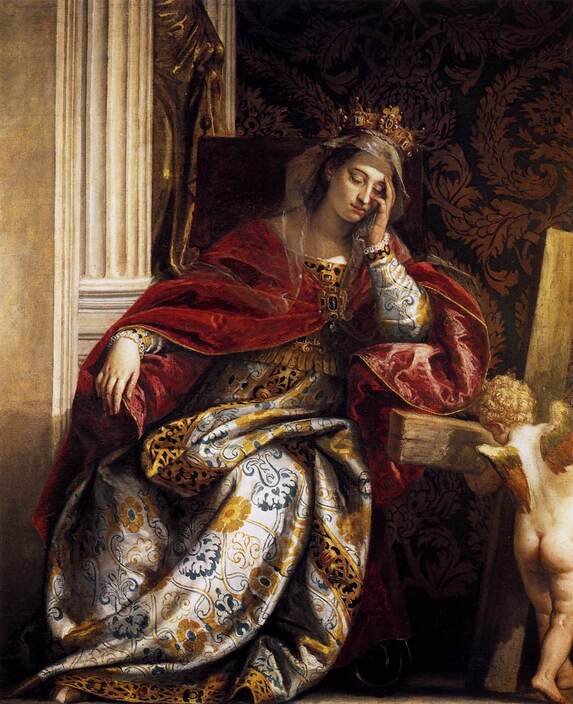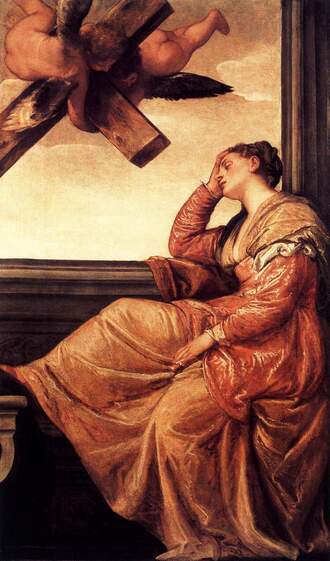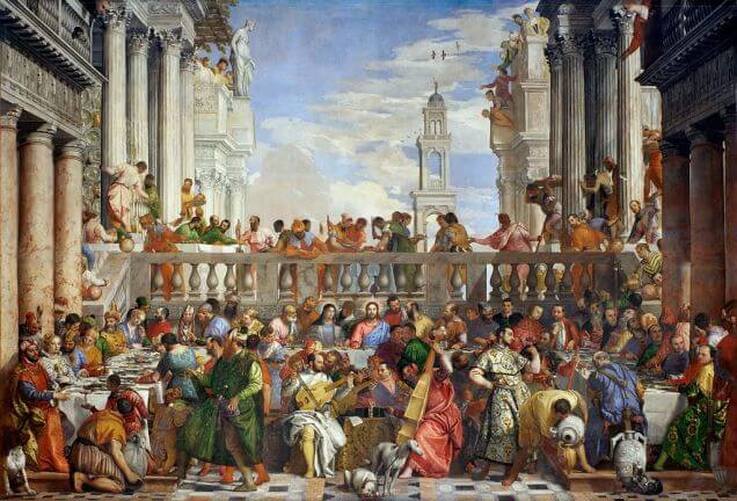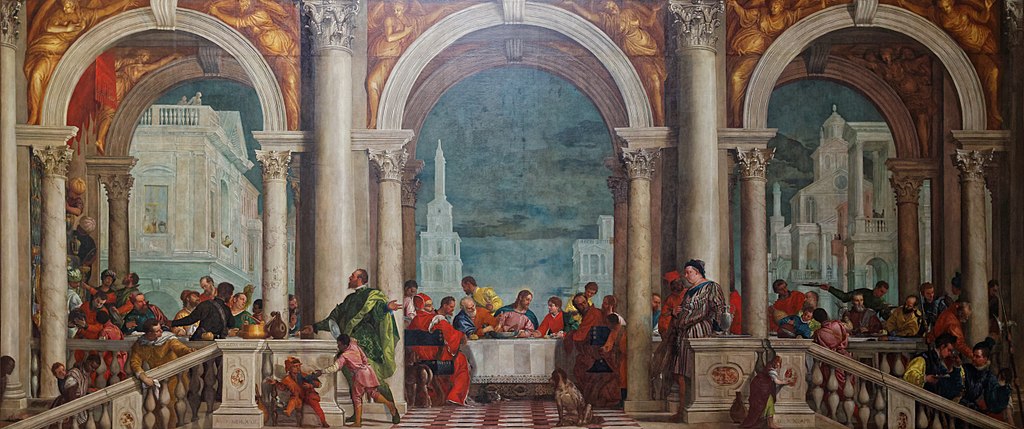|
Where? Room 10 of the Pinacoteca in the Vatican Museums
When? Around 1580 Commissioned by? Unknown What do you see? Saint Helena has a vision of the location of the True Cross (the cross on which Jesus was crucified on Golgotha). Helena is peacefully dreaming about the wooden cross of Jesus which is held in this painting by the winged cherub on the right. The naked cherub stands with his back toward the viewer. Helena sits on a chair within a palace-like building (indicated by the two big columns, the gold statue in between them, and the large patterned curtain behind her). She has her eyes closed and supports her head with her left hand. Helena wears an expensive 16th-century silk dress with beautifully-painted folds. On top of the dress is a red cloak which is fastened by a big golden brooch. In the middle of the brooch is a carved image of a cupid. She has a transparent veil on her head and a crown filled with jewels on top of it, indicating that she is the Empress of the Roman Empire (as she was the mother of Emperor Constantine). Backstory: This painting is also referred to as Vision of St. Helen. In 1565, Veronese painted another version of The Vision of Saint Helena (also called The Dream of Saint Helena). That painting has the same theme as the current painting and is in the National Gallery in London. The style of both versions differs substantially, which is a testament to the versatility of Veronese’s painting style.
Who is Saint Helena? She was born in 250 AD, probably in a low-standing family. She became the partner of Constantius Chlorus who would become the Roman Emperor in 293. However, Constantius divorced her in 289 to find a wife with a status that would better match his future role as the Emperor. Before the divorce, they got a child, Constantine. He would become Emperor Constantine (272-337 AD), also known as Constantine the Great.
Helena is known for the big influence she had on her son. She was an important reason that Constantine became the first Christian Emperor and he subsequently promoted Christianity throughout the Roman Empire. During a trip to Jerusalem, she allegedly discovered the True Cross. What is the True Cross? The cross on which Jesus was crucified. After the crucifixion, the cross of Jesus and the crosses of the two people who were crucified with him got lost. There are several accounts of how Saint Helena discovered the cross, and they all differ from each other. According to some, in 326-328, Saint Helena traveled to Palestine, and she found the three crosses in Jerusalem. One of the crosses carried the name of Jesus. However, real evidence came when a miracle occurred. A very sick woman arrived at the crosses. She touched the first two crosses and nothing happened, but when she touched the cross of Jesus, she got cured immediately. Nowadays, many Catholic and Orthodox churches claim to have a small fragment of the True Cross. Who is Veronese? Paolo Caliari (1528-1588) was born in Verona which explains that he is better known under the name Paolo Veronese. He spent most of his adult life in Venice. He is considered to be one of the three masters of the Venetian School of Painting, together with Tintoretto and Titian. Veronese usually created colorful paintings, full of drama, often with beautiful architectural elements. The people in his paintings are often painted quite realistically, elegant, and dressed in luxurious clothes. Veronese is most famous for some of his larger paintings, such as The Wedding at Cana in the Louvre and The Feast in the House of Levi in the Gallerie dell’Accademia in Venice.
Fun fact: This painting shows a calm and peaceful scene. However, most of the work by Veronese shows a considerable amount of drama. One typical aspect of Veronese’s style that is present is the use of vibrant colors, especially for the clothes of Saint Helena. The dress mainly contains gold, blue, and white and the large folds of the dress and the way the light falls on it, really make it stand out. The combination with the red cloak makes this a very warm, yet vibrant, painting. The clothes of Saint Helena seem to confirm the claim by the French poet Gautier that Veronese was the greatest colorist who ever lived.
Written by Eelco Kappe
References:
0 Comments
Leave a Reply. |
Categories
All
|
- Home
- Blog
-
Museums
- Alte Pinakothek
- Art Institute of Chicago
- Baltimore Museum of Art
- Barber Institute of Fine Arts
- Bargello
- Barnes Foundation
- British Museum
- Church of Sant’Anastasia
- Cleveland Museum of Art
- Courtauld Institute of Art
- Detroit Institute of Arts
- Frans Hals Museum
- Galleria Borghese
- Gallerie dell'Accademia
- Getty Museum
- Guggenheim
- Hermitage Museum
- Kunsthistorisches Museum
- Kunstmuseum Basel
- Legion of Honor Museum
- Louvre
- Mauritshuis
- Metropolitan Museum of Art
- Musee d’Orsay
- Museum of Fine Arts in Boston
- Museum of Modern Art
- National Gallery in London
- National Gallery of Art
- National Museum in Poznań
- Norton Simon Museum
- Ny Carlsberg Glyptotek
- Palace of Versailles
- Palazzo Pitti
- Palazzo Vecchio
- Petit Palais
- Philadelphia Museum of Art
- Prado
- Pushkin Museum
- Ravenna Art Museum
- Rijksmuseum
- San Diego Museum of Art
- Santa Maria delle Grazie
- St. Peter's Basilica
- Städel Museum
- Statens Museum for Kunst
- Tate Britain
- Tate Modern
- Timken Museum of Art
- Uffizi
- Vatican Museums
- Wallace Collection
-
Artists
- Altdorfer
- Anguissola
- Berlin Painter
- Bosch
- Botticelli
- Boucher
- Bronzino
- Bruegel the Elder
- Brunelleschi
- Cabanel
- Caillebotte
- Canova
- Caravaggio
- Carpeaux
- Cezanne
- Cimabue
- David
- Degas
- Delacroix
- De Maria
- Donatello
- El Greco
- Fontana
- Fra Angelico
- Fragonard
- Gauguin
- Gentileschi
- Gericault
- Gonzalez-Torres
- Goya
- Hals
- Hogarth
- Hokusai
- Ingres
- Leonardo da Vinci
- Lippi, Filippo
- Longhi, Barbara
- Lorrain
- Makovsky
- Manet
- Massys
- Matisse
- Merian
- Michelangelo
- Mochi
- Modigliani
- Monet
- Panini
- Parmigianino
- Perugino
- Picasso
- Pisanello
- Raphael
- Rembrandt
- Renoir
- Reynolds
- Rivera
- Rodin
- Rubens
- Scultori
- Seurat
- Steen
- Tintoretto
- Titian
- Toulouse-Lautrec
- Turner
- Uccello
- Van der Weyden
- Van Dyck
- Van Eyck
- Van Gogh
- Van Hemessen
- Vasari
- Velazquez
- Vermeer
- Veronese
- Vigée Le Brun
-
Locations
- Books
- About Us




